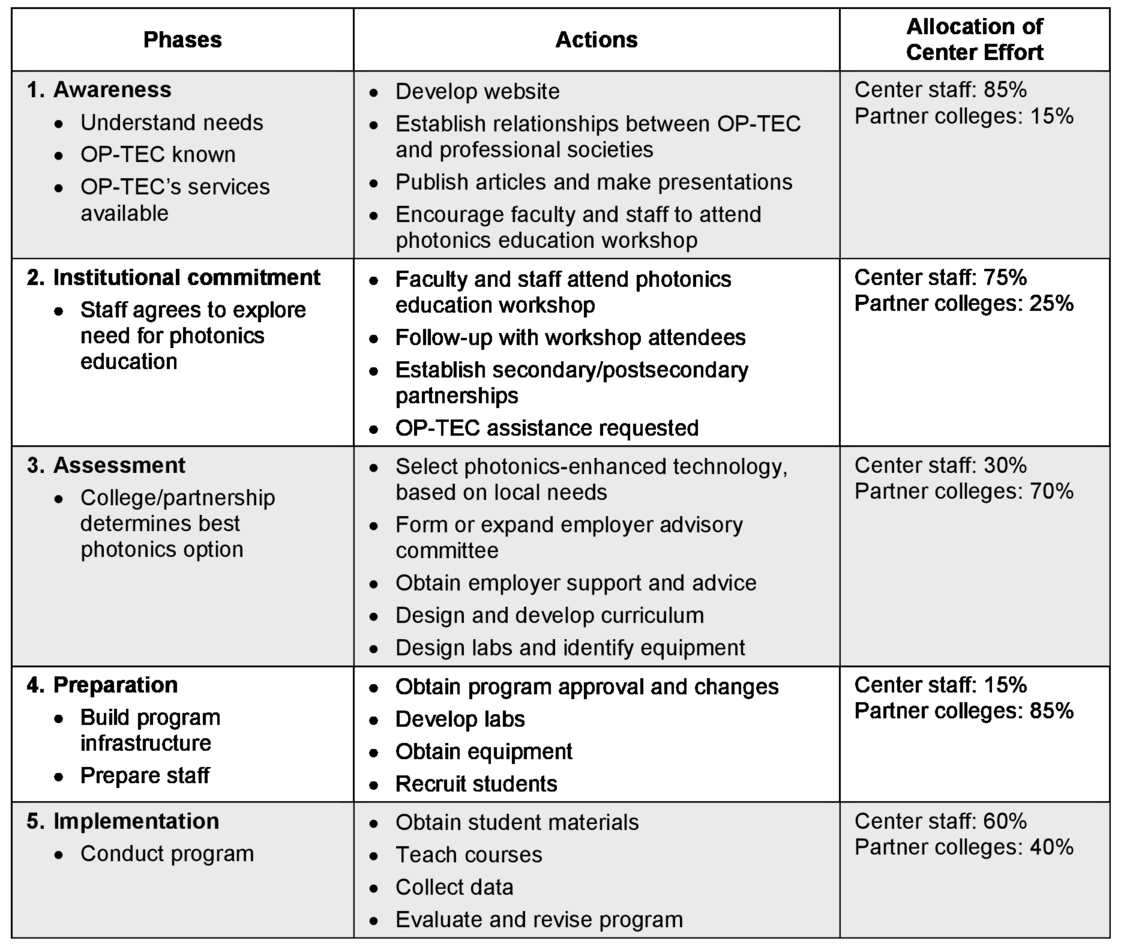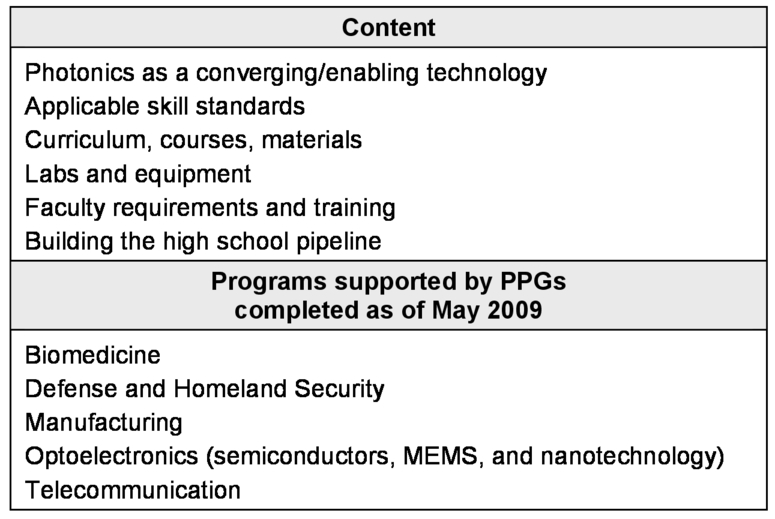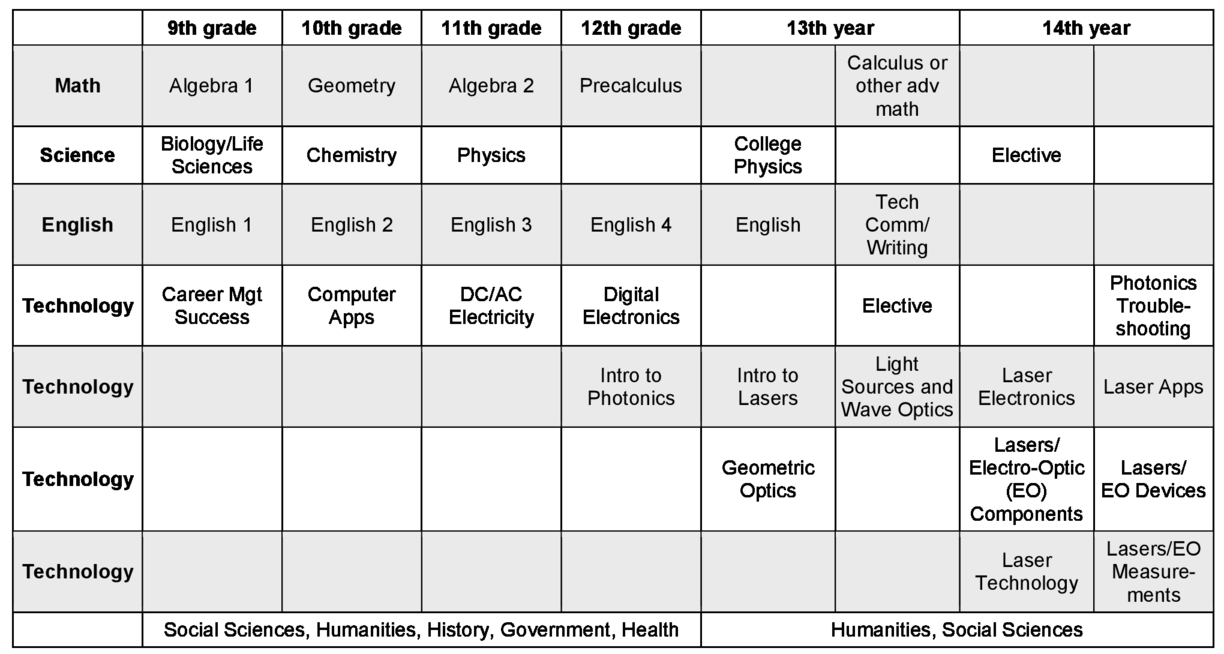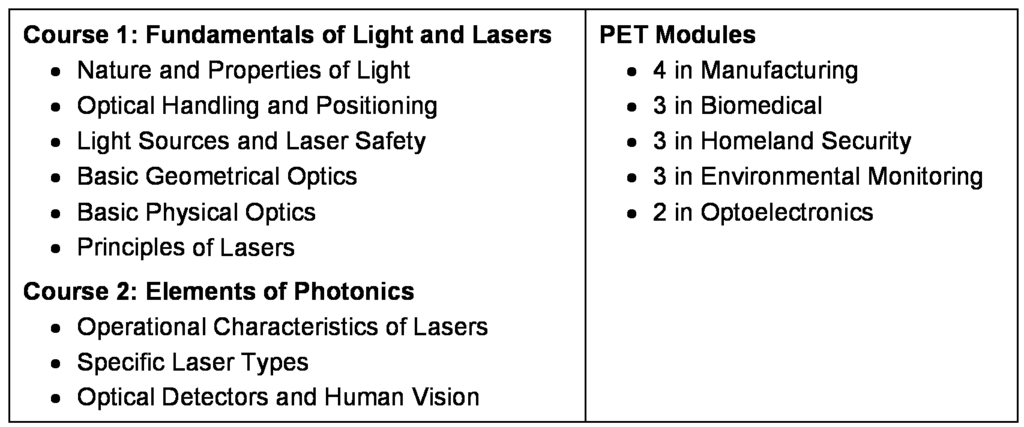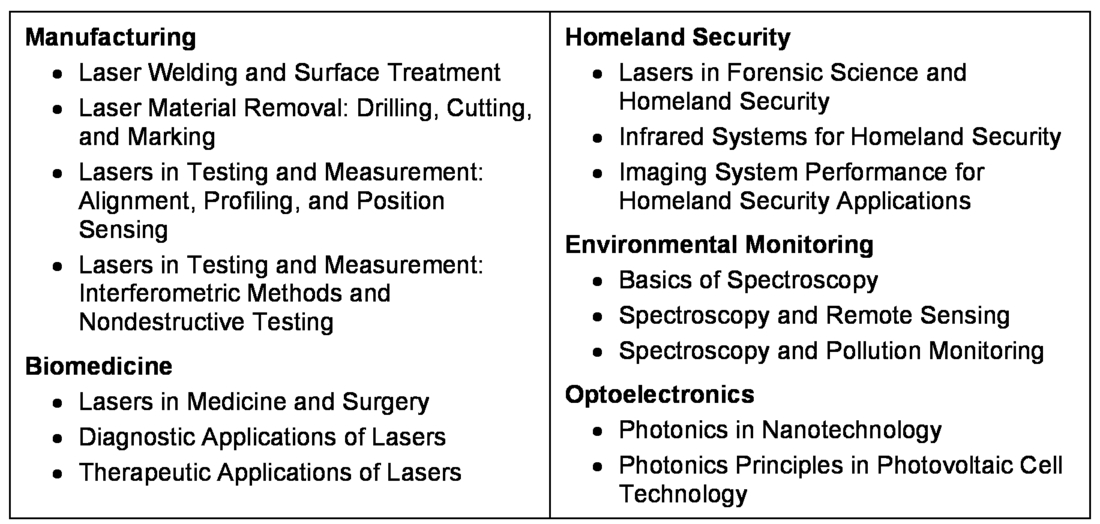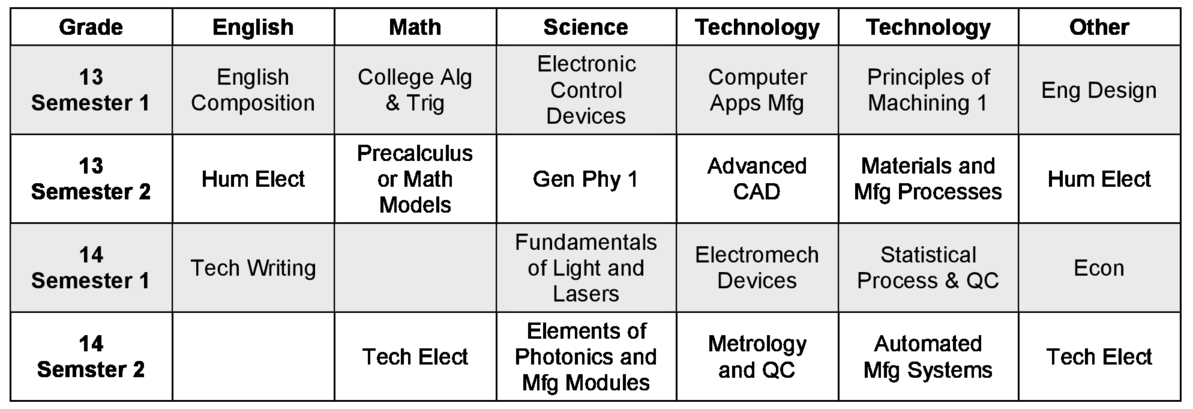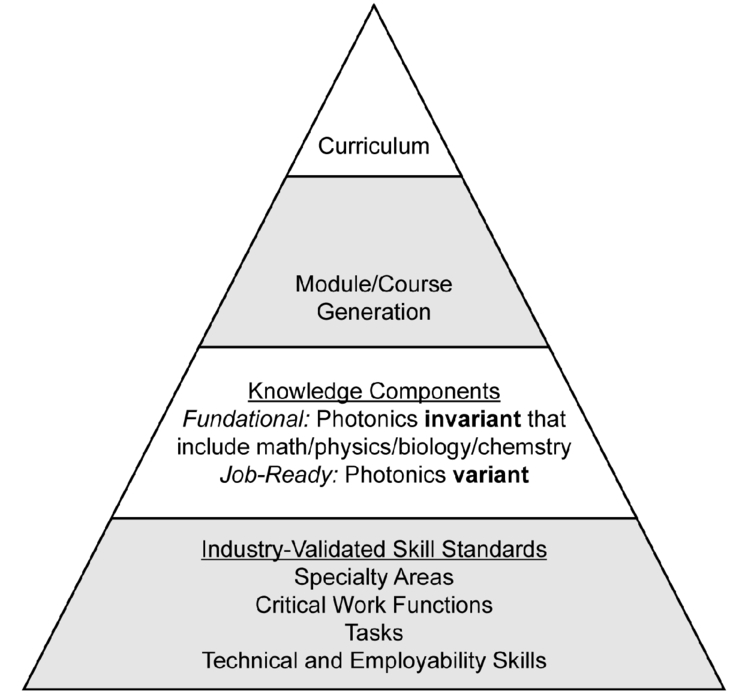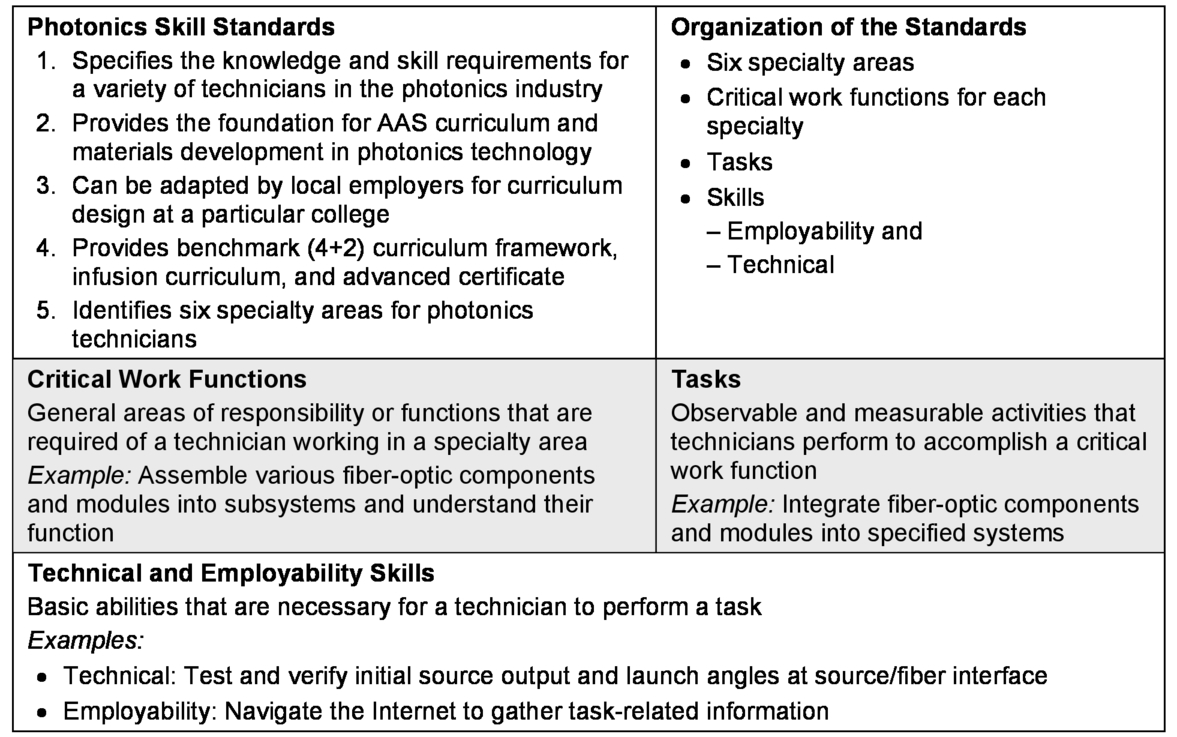|
|
1.MISSION/ORGANIZATIONThe National Center for Optics and Photonics Education (OP-TEC) is a National Science Foundation (NSF) Advanced Technological Education (ATE) National Center of Excellence. OP-TEC’s mission is to create a secondary-to-postsecondary “pipeline” of highly qualified and strongly motivated students and to empower high schools and community colleges to meet the urgent need for technicians in optics and photonics. Under its current grant from NSF, OP-TEC has been awarded five million dollars over a period of four years. OP-TEC has focused its energy primarily on building the capacity of community and technical colleges to use their existing program infrastructures to train and educate photonics technicians that will meet industry’s current and future need for these specialized workers. OP-TEC is a consortium of colleges whose efforts are coordinated and directed by its PI, Dan Hull, and four Co-PI’s: Dr. Fred Seeber, Dr. Chrys Panayiotou, Dr. Larry Grulich, and Dr. M.J. Soileau. The consortium of partner colleges comprises Camden County College, Indian River State College, Indiana University of Pennsylvania, Indian Hills Community College, Tri-County Technical College, Irvine Valley College, Central Carolina Community College, and Texas State Technical College. 2.SUPPLY AND DEMANDA key step in the fulfillment of OP-TEC’s mission is to determine (1) the demand, now and in the future, for photonics technicians and (2) the capacity of community and technical colleges to meet that demand. In 2008, OP-TEC commissioned two studies to determine the relevant supply and demand parameters. 2.1.SupplyThe purpose of the first study was to determine the capacity of U.S. colleges to produce photonics technicians.2 To collect this information, the study used both Internet searches and telephone surveys. The Internet searches identified postsecondary institutions in the U.S. that offer photonics instruction (from single courses to full programs) that can contribute to the training and education of photonics technicians. The telephone surveys confirmed that the identified colleges still offer this instruction and determined the number of students enrolled and the number of program completers. All the institutions that contributed to the final results of the survey indicated that they have active photonics instructional offerings (at least one course in photonics, optics, and/or laser technology) and that their former students are employed in the optics/photonics industry as a result of their participation in that instruction. The results of the survey indicated that 600–700 students are enrolled in programs that are capable of leading to technician-level employment in the photonics industry. However, only 250–300 are completing their programs each year and are available to fill industry positions. 2.2.DemandTo determine the demand side, OP-TEC commissioned the University of North Texas Survey Research Center to contact by telephone a large random sample of industrial companies throughout the U.S. that perform R&D with optics, lasers, and photonics technology or are original equipment manufacturers (OEM) for R&D companies. The goal was to determine how many photonics technicians the companies employ, the additional number they will need in 2009, and the number they will need five years from now. Using the Laurins Publishing Company Photonics Directory (2008) and OP-TEC databases, the researchers identified a total of 3989 U.S. photonics companies. The researchers contacted over 2500 of those companies before generating a representative sample of 663 companies, of which 300 employ photonics technicians. Besides employment data, the survey collected information on the educational levels of the photonics technicians currently employed; the employers’ preferences with respect to the levels of education those technicians should have; and the types of jobs photonics employers are seeking to fill. After performing a statistical analysis of the survey, the researchers issued a final report.3 The results showed that over 19,000 photonics technicians are employed in the U.S., that over 2100 additional photonics technicians will be needed next year, and that approximately 5900 will be needed in five years (2014). When the supply and demand results are compared, it is clear that for the U.S. to meet its demand for these workers, community and technical colleges must substantially increase the numbers of their graduates and program completers. For example, let’s assume that in 2010 U.S colleges can add 300 new technicians to the pool of photonics workers. This will fall far short of the 2100 workers needed. Helping to close the gap between supply and demand is one of OP-TEC’s primary challenges. To meet this challenge it must empower colleges to increase enrollments in their existing photonics and photonics-related programs and to implement new programs. In addition to the challenge of increasing college capacity, OP-TEC must work to ensure that new technicians possess the skills and knowledge necessary for success in the photonics industry. To meet this second challenge, OP-TEC must provide relevant and effective curriculum and instructional materials. The remainder of this paper addresses these two challenges and outlines OP-TEC’s response to them. 3.INCREASING THE SUPPLYIncreasing the supply of photonics technicians is directly related to expansion of the base of colleges that offer photonics education and training. Though simple in concept, expanding this base requires a systematic process for enabling colleges to implement photonics programs. OP-TEC has developed and is implementing an aggressive process for recruiting new colleges and assisting them in adding photonics content to their existing curricula. This process (outlined below) consists of five phases, as illustrated in Figure 1. Phase 1: Awareness. The main purpose of this phase is to make two-year colleges (TYC), both community and technical colleges, and secondary school systems (SSS) aware of the existence of OP-TEC and its mission. In this phase, OP-TEC works to establish itself as the point-of-contact for all matters related to the education and training of photonics technicians. OP-TEC works to help the TYCs and SSSs recognize that photonics is a high-demand, high-pay technical field that is still emerging and has great growth potential. Phase 2: Institutional commitment. This phase has two main objectives. One is getting TYCs and SSSs to commit to an assessment of their need for photonics programs or, if the need has already been established, commit to program implementation. The other objective is to assist institutions in developing secondary/postsecondary partnerships on which to build 4+2 career pathways. Phase 3: Assessment. The main purpose of this phase is to determine the best way to implement a photonics program in a given TYC. In this phase OP-TEC works closely with the educational organization to provide survey instruments for assessing need within its service area, to provide a list (through professional societies) of potential photonics employers in its service area, and to help the organization establish an advisory board or add members to an existing board that can provide guidance in the photonics area. The primary outcomes of this phase are to:
To help meet these outcomes, OP-TEC provides program planning guides (PPG) that detail the requirements for adding photonics programs. The guides are designed to enable college decision makers to quickly grasp the implications of adding photonics to their program offerings. Figure 2 provides more detail about the PPGs. Phase 4: Preparation. The main purpose of this phase is to help the educational organization build the infrastructure necessary to implement the program, as outlined in phase 3 (assessment). OP-TEC provides a professional development course designed to prepare faculty to present photonics topics. OP-TEC also works with faculty to locate and procure the laboratory equipment identified in phase 3 (assessment). During this phase, OP-TEC helps the educational organization prepare to implement a photonics program by assisting the organization in gaining state and/or local program approval, developing labs, purchasing equipment, training instructors, and recruiting students. Phase 5: Implementation. In this phase, OP-TEC and its partner colleges act as advisors to ensure the successful launch of new photonics programs. OP-TEC helps educational organizations assess the effectiveness of their programs by helping them develop means for surveying their employer bases and making program adjustments as dictated by the results of the surveys. The process described in the preceding paragraphs is designed to achieve OP-TEC’s goal of building capacity at U.S. colleges to educate and train photonics workers. The process is also designed to amplify the assets available at OP-TEC and provide a sustainable means of expanding photonics education. The success of the process will depend heavily on close collaboration between OP-TEC and educational institutions that implement new photonics programs. Over 200 colleges are involved in the OP-TEC recruitment process. Seventy-one are beyond phase 1 (awareness) and four have reached phase 5 (implementation). As it works with the colleges, OP-TEC leverages its resources by assigning mentors from its partner colleges. The extent of this mentorship is indicated in the right column of Figure 1 as the percentage of the overall effort contributed by the partner colleges in each of the five phases. For instance, in phase 1 (awareness) little mentorship is needed, but in phases 3 (assessment) and 4 (preparation) the extent of the mentorship needed is substantial. 3.1.Empowerment services provided by OP-TECIn carrying out the process outlined in the previous section, OP-TEC offers several services designed to empower colleges to advance through the process. These services can be categorized in the following five broad areas:
Through these services, OP-TEC empowers colleges to design photonics programs that best meet the needs of the industries in their service areas. 4.CURRICULUM AND INSTRUCTIONAL MATERIALS DEVELOPMENTDuring the college recruitment process, a strategic decision must be made as to what audience(s) the college will serve and what programs should be put in place to serve them. These decisions, which are typically made by advisory committees composed of representatives of industries in the colleges’ service areas, usually focus on three options. (1) If a college’s service area is heavily represented by photonics R&D or laser OEMs, the college should consider implementing an AAS program in photonics. (2) If the college’s service area is heavily represented by companies that use photonics as an enabling technology, the college should consider infusing photonics into the technical programs from which these employers hire their technicians. (3) A third option is the advanced certificate program, a non-degree-granting program designed to upgrade and/or update the skills of photonics technicians already employed. OP-TEC has developed curriculum for all three options. The AAS degree (Figure 3) is a benchmark 4+2 articulated program that allows effective “pipeline building” from high schools to colleges. The photonics courses listed in the postsecondary portion are supported by OP-TEC’s Laser/Electro-Optics Technology Series course materials. The advanced certificate (Figure 4) provides a means for already employed technicians to learn about photonics and its application in the technicians’ areas of specialization. Courses that are to be taught along with the photonics course in advanced certificate programs will vary according to local industry needs. Electronics was chosen for this example, since it tends to be one of the most rapidly changing technologies in most technical fields and thus requires constant update training. The photonics courses listed in Figure 4 are supported by OP-TEC’s Optics and Photonics Series. Figure 5 presents the content of the courses and shows the specialty areas that can be added to the Elements of Photonics course to customize it to local industry needs. Figure 6 provides topical information on OP-TEC’s Photonics Enabled Technology (PET) materials, which are specifically designed for use as specialty modules in advanced certificate programs or infusion curricula. A typical infusion curriculum is shown in Figure 7. This curriculum treats photonics as an enabling technology in manufacturing. Once again, the two courses in OP-TEC’s Optics and Photonics Series are embedded, thus enabling students to learn the role of photonics in materials processing. The manufacturing modules listed are the four PET manufacturing modules listed in Figure 6. 4.1Instructional materials development and updatingCurriculum provides a pathway that enables students to achieve academic goals in predefined structures that enhance their learning. However, even if a curriculum meets students’ goals and helps them to learn, it is not valuable unless it uses instructional materials that are relevant to the workplace and meet the needs of employers. The process used to develop OP-TEC’s instructional materials treats employer needs as foundational. Figure 8 depicts the development process as a pyramid. At the base of the pyramid are industry-validated skill standards. Skill standards are employer specifications for the knowledge and skills required for success in specified technical areas. OP-TEC developed The National Photonics Skill Standards for Technicians in 1995. Because photonics applications have undergone rapid change in the last decade, the standards have been revised twice; the third edition was completed in 2008. The revision efforts were led by photonics industry representatives and reflect their inputs as to the current needs of the U.S. photonics industry. Updates and revisions of the skill standards are critical in maintaining the currency and relevance of the instructional materials based on the standards. All OP-TEC materials referenced in this paper are based on these standards and have been or are being updated to reflect changes made in the third edition. Figure 9 provides more detail on the structure, organization, and components of the standards. Copies can be downloaded from the OP-TEC website (www.op-tec.org). 5.SUMMARYThis paper has presented two of the major challenges facing OP-TEC: (1) increasing the capacity of U.S. colleges to produce photonics technicians and (2) developing and maintaining relevant, up-to-date curriculum and instructional materials. Through OP-TEC’s partner colleges and the generous support of the National Science Foundation, these challenges are being met. OP-TEC has developed processes for assisting colleges in implementing photonics programs and providing curriculum and instructional materials to ensure the work-readiness of program completers. These processes and instructional products are resources that can be used internationally in building the strength of the photonics technician workforce. We invite our international colleagues to review and implement these processes and give us feedback on their effectiveness. It is our hope that through this feedback we can make even greater strides in filling industry’s need for highly skilled technicians. REFERENCESHull and Gutzwiller, , Two-year College Enrollment and Completion Rates: An Estimation of Workforce Supply for Technicians in Optics, Photonics, and Laser Technology, OP-TEC Working Paper Series, Working Paper #5, 2008 Google Scholar Hull, Ruggiere, and Illich,
“Photonics Technician Employment in the United States: An Industry Survey of Current and Future Demand in 2009 for Education and Training Programs,”
OP-TEC Monograph,
(2009). Google Scholar
|

